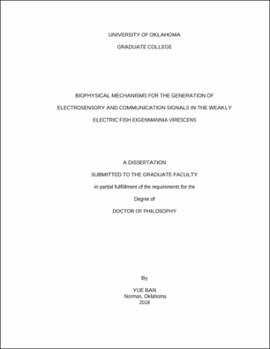| dc.description.abstract | The weakly electric fish Eigenmannia virescens generates electric organ discharges (EODs) to navigate and communicate. The EODs are brief monophasic voltage pulses with brief inter-pulse intervals, resulting in a sinusoidal waveform. EODs are produced by the simultaneous action potentials (APs) of ~1000 electric organ (EO) cells (electrocytes). Electrocytes generate APs at steady frequencies of 200-600 Hz with Na+ currents that exceed 10 microamperes during each AP, creating large energetic demands. The aim of this study was to investigate the biophysical mechanisms that allow fast spiking and manage the large ionic currents in electroctyes.
E.virescens elecrocytes initiate the AP using voltage-gated Na+ (Nav) channels and terminate the AP using Na+-activated K+ (KNa) channels, rather than voltage-gated K+ (Kv) channels, as is the case in other electric fish where electrophysiological data are available. The characteristics of K+ channels are key determinants of an excitable cell’s firing pattern. Using degenerate PCR and RACE-PCR, I identified the presence of three types of KNa channel subunit in electrocytes, eSlack1 and eSlick, closely related to KNa channel subunits in other vertebrates, and a shorter isoform, eSlack2. Whole-cell currents recorded from Xenopus laevis oocytes expressing these KNa channels revealed that eSlack1 and eSlick can form functional homomeric K+ channels and eSlick currents activated much more rapidly than eSlack1 currents. eSlack2 could not form functional homomeric ion channels, even though the subunits could be successfully trafficked to the plasma membrane.
To investigate how ion channels coordinate to generate high-frequency APs, I studied the expression pattern of ion channels and Na+/K+ ATPases using immunohistochemistry and by expressing fluorescent protein-tagged ion channels in electrocytes. Cholinergic receptors and Nav channels are only localized on the posterior side, while all K+ channels including the three KNa channel subunits and the ATP sensitive Kir6.2 are expressed on the anterior side. Na+/K+ ATPases are widely distributed on both the posterior and anterior membranes. Two-photon 3D imaging of electrocytes showed the cell’s posterior membrane is densely occupied by narrow invaginations providing extensive surface area for the expression of Na+ channels and Na+/K+ ATPases to manage the large ionic currents. Abundant vesicles were present underneath the posterior membrane, which may be associated with the trafficking of Na+ channels and Na+/K+ ATPases to the plasma membrane when the amplitude of AP is under modulation.
Finally, I investigated the ionic mechanisms associated with variations in AP frequency in the fast-spiking electrocytes by measuring the transcription levels of ion channels and ion transporters in EO from fish with different EOD frequencies. EOD frequency is correlated with the transcription levels of Nav1.4a, the fast-activating Slick KNa channel subunits, Kir6.2 and Na+/K+ ATPases but not Nav1.4b, eSlack1 and eSlack2.
In summary, the fast-activating Slick KNa channels are expressed exclusively in electrocytes to support the generation of sustained high-frequency APs. Among all the ion channels and ion transporters expressed in electrocytes, only Slick KNa channels, Nav1.4a, and Na+/K+ ATPases are associated with increased excitability, and these transcripts are expressed predominantly in electrocytes when compared to skeletal muscle. Variations in the transcription levels of eSlick, Nav1.4a and Na+/K+ ATPases are positively correlated with individual differences in EODf, where they likely contribute to the capacity for high-frequency firing. | en_US |
